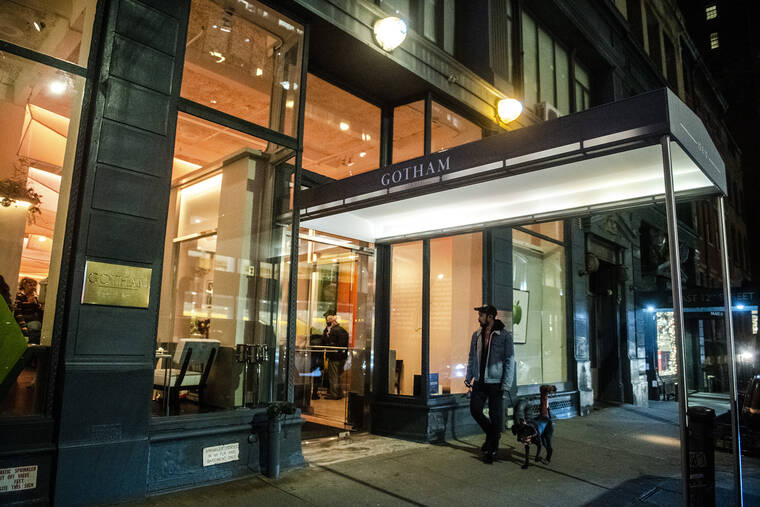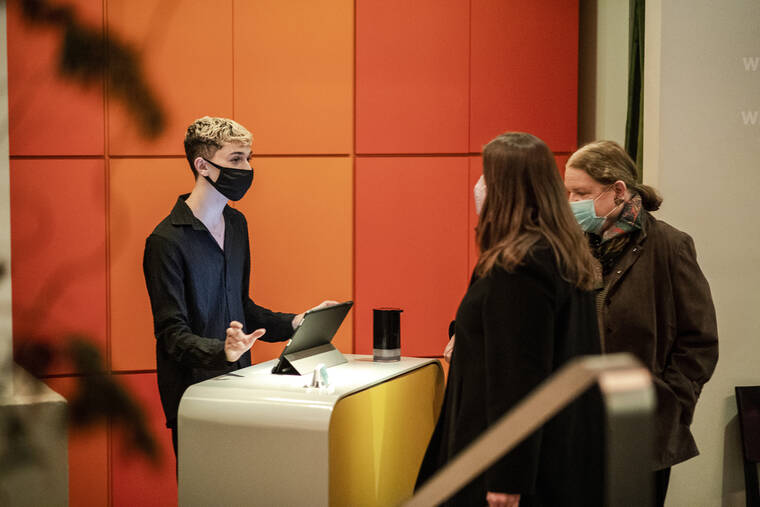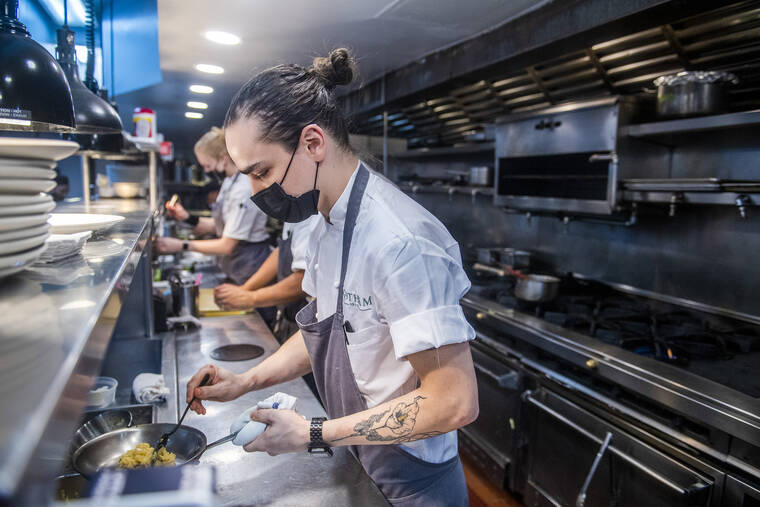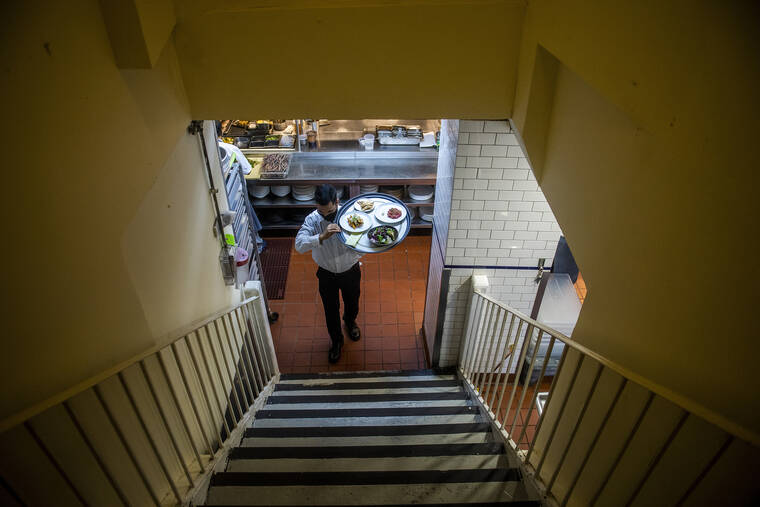Supply shortages and emboldened workers: A changed economy

A pedestrian passes the entrance to Gotham restaurant on Tuesday, Dec. 14, 2021, in New York. When COVID-19 tore through the United States in March 2020, the recession it caused was brutal yet brief. Yet for much of 2021, the recovery was undermined by new threats: A surge in inflation that shrank the value of paychecks, hurt the least advantaged Americans most and posed a political threat to President Joe Biden and Democrats in Congress. (AP Photo/Brittainy Newman)

People dine at Gotham restaurant on Tuesday, Dec. 14, 2021, in New York. When COVID-19 tore through the United States in March 2020, the recession it caused was brutal yet brief. Yet for much of 2021, the recovery was undermined by new threats: A surge in inflation that shrank the value of paychecks, hurt the least advantaged Americans most and posed a political threat to President Joe Biden and Democrats in Congress. (AP Photo/Brittainy Newman)

People check in at Gotham restaurant on Tuesday, Dec. 14, 2021, in New York. When COVID-19 tore through the United States in March 2020, the recession it caused was brutal yet brief. Yet for much of 2021, the recovery was undermined by new threats: A surge in inflation that shrank the value of paychecks, hurt the least advantaged Americans most and posed a political threat to President Joe Biden and Democrats in Congress. (AP Photo/Brittainy Newman)

Sebastian Cacho cooks in the kitchen at Gotham restaurant on Tuesday in New York. When COVID-19 tore through the United States in March 2020, the recession it caused was brutal yet brief. Yet for much of 2021, the recovery was undermined by new threats: A surge in inflation that shrank the value of paychecks, hurt the least advantaged Americans most and posed a political threat to President Joe Biden and Democrats in Congress. (AP Photo/Brittainy Newman)

Muhammad Rahman delivers orders at Gotham restaurant on Tuesday in New York. When COVID-19 tore through the United States in March 2020, the recession it caused was brutal yet brief. Yet for much of 2021, the recovery was undermined by new threats: A surge in inflation that shrank the value of paychecks, hurt the least advantaged Americans most and posed a political threat to President Joe Biden and Democrats in Congress. (AP Photos/Brittainy Newman)
Employees at a fast-food restaurant in Sacramento, California, exasperated over working in stifling heat for low wages, demanded more pay and a new air conditioner — and got both.
Employees at a fast-food restaurant in Sacramento, California, exasperated over working in stifling heat for low wages, demanded more pay and a new air conditioner — and got both.
Customer orders poured in to an Italian auto supplier, which struggled to get hold of enough supplies of everything from plastic to microchips to meet the demand.
A drought in Taiwan magnified a worldwide shortage of computer chips, so vital to auto and electronics production.
The global economy hadn’t experienced anything like this for decades. Maybe ever. After years in which ultra-low inflation had become a fixture of economies across the world, prices rocketed skyward in 2021 — at the grocery store, the gasoline pump, the used-car lot, the furniture store. Chalk it up to a surprisingly swift and robust economic recovery from the pandemic recession, one that left suppliers flat-footed and hampered by COVID-19 disruptions.
U.S. workers, having struggled for years to achieve economic gains, secured better wages, benefits and working conditions — and the confidence to quit their jobs if they didn’t get them.
Global supply chains that ran efficiently for years broke down as factories, ports and freight yards buckled under the weight of surging orders.
Propelled by vast infusions of government aid and the widespread distribution of COVID vaccines, the economic bounce-back was as startling as the fall that had preceded it. Policymakers, business owners and economists were caught off-guard by both the speed of the recovery and the new COVID variants that threatened its durability.
They had never, after all, had to manage the unpredictable fallout, economic and otherwise, from a global pandemic.
BACK FROM THE BRINK
In the spring of 2020, the global economy appeared to stand on the brink of a catastrophe. The sudden and blindingly fast spread of COVID-19 infections forced lockdowns, frightened people into hunkering down at home, paralyzed travel and ordinary business activity and led employers to slash tens of millions of jobs.
In June that year, the International Monetary Fund predicted that the global economy would shrink 4.9% for the year, the first drop in worldwide economic output since the 2008-2009 financial crisis.
But the governments of the wealthiest nations, scarred by the achingly slow recovery from the financial crisis just over a decade earlier, poured money into rescuing their economies. The United States was particularly aggressive: It supplied $5 trillion in COVID-related stimulus aid to individuals, businesses and municipalities this year and last.
“The U.S. has been a total outlier globally,” said Robin Brooks, chief economist at the Institute of International Finance, a global trade group for financial companies.
“We had the deepest pocketbook of any country. We have this exorbitant privilege” — the ability to run up debts to pay for COVID relief without having to pay high interest rates to do so. Global investors regard U.S. government debt as perhaps the safest investment around; their purchases of U.S bonds keep American interest rates low.
So despite immense federal spending and surging inflation, the yield on the benchmark 10-year Treasury note — below 1.4%, as of early Friday — remains lower than it was before the pandemic.
In the United States and elsewhere, stimulus aid is widely credited with helping stave off disaster. Though the global economy did shrink in 2020, it did so by a less-than-expected 3.1%. And the IMF expects growth to rebound to 5.9% for 2021. That would be the fastest calendar-year expansion in IMF records dating to 1980.
Beginning earlier this year, vaccines accelerated the return to something much closer to ordinary pre-pandemic life.
“We got this scientific miracle,” said Jacob Kirkegaard, senior fellow with the German Marshall Fund of the United States. “We had a vaccine that was available six to nine months earlier than anybody had really believed in 2020 … What that meant was that the second half of 2021 saw basically a general reopening in all of the advanced economies, and that was certainly was a massive positive surprise.”
COVID UNCERTAINTY
Still, the virus itself has continued to complicate anyone’s ability to forecast where the economy was headed or to determine what to do about it. A wave of infections over the summer, for instance, sent Japan’s economy into a nasty tailspin: It shrank from July through September at a 3.6% annual rate.
Likewise, America’s recovery lost momentum once the highly contagious delta variant erupted over the summer. Growth slowed to a 2.1% annual rate from July through September, sharply down from a 6.7% rate in the April-June quarter and 6.3% in the January-March period.
Overall, though, the economy has recovered with surprising vigor. In June 2020, with the economy still reeling from the pandemic, the Federal Reserve’s policymaking committee forecast that unemployment would average 9.3% in the final three months of the year and 6.5% at the end of 2021. In reality? The jobless rate plummeted from 11.1% in June 2020 to 6.7% by year’s end. It’s now at a near-fully healthy 4.2%.
Flush with government payments and, in many cases, savings accrued from working at home and from stock-market gains, people in rich countries were sitting on larger piles of cash and spending a lot of it.
Capital Economics calculates that households in advanced economies like the United States and the European Union were holding “excess savings” at mid-year of $3.7 trillion — the amount above what they would likely have saved if the pandemic had never happened.
OVERWHELMED
In some ways, it’s been too much of a good thing.
Robust demand, especially for autos, appliances and other physical goods, overwhelmed global manufacturers. Factories couldn’t obtain enough raw materials and parts. Ports and freight yards were swamped. Companies grappled with shortages of everything they needed, notably workers.
That was particularly true at many restaurants. At the newly re-opened Gotham restaurant in Manhattan, for instance, patrons are unable to find handcrafted chocolates, once a big draw for the holidays, or grab a burger or order oysters. Gotham couldn’t find enough employees to make the chocolates, work the grill or shuck the oysters.
“We worked to bring the restaurant back to life,” said Bret Csencsitz, the new owner of the restaurant. “The demand is there. The product is superior. Yet I don’t have enough people to make the business what it needs to be and what it should be.”
The restaurant was also hampered by shortages of basic supplies like ceramic plates and glassware. Food costs fluctuated wildly. Halibut, which cost $14 a pound one day, was $24.99 a week and a half later.
Across the Atlantic, MTA, an auto components manufacturer that endured Italy’s first lockdown in February 2020, reopened within a week and ended 2020 with unexpectedly healthy business. But the recovery bred new troubles.
“Everything is lacking,” said Maria Vittoria Falchetti, the company’s marketing chief.
“Plastic is lacking. Metals are lacking. Paper is lacking. Microchips — don’t even mention. Also, we are struggling with a big increase in prices in these materials, and also energy,”
In Asia, manufacturers of everything from toys to cellphones suffered from a global shortage of computer chips and surging costs for components, raw materials and shipping.
Kaixiang Electric Appliance Co., which makes LED lamps and flashlights in Ningbo, south of Shanghai, paid 20% more in 2021 for labor, materials and complications resulting from shipping bottlenecks.
“The current delay in delivery is about one or two months,” said Susan Yang, CEO of the 80-employee company.
“The sharp rise in sea freight has eaten into manufacturers’ profits and ours,” said Max Chen, general manager of Makefigure Co., a toymaker in the southern Chinese city of Shenzhen. “If we want to stay in the business, we need to lower our profit expectations and develop new clients.”
The supply chain problems have been compounded by what Kirkegaard of the German Marshall Fund calls “idiosyncratic things.”
A drought in Taiwan curtailed production at water-dependent computer chip plants. A February deep freeze shut down petrochemical plants in Texas. A huge container ship got stuck in the Suez canal for a week in March and cut off shipping between Asia and Europe.
THE PAIN OF HIGH PRICES
The supply chain bottlenecks have driven up costs, contributing to a problem that most rich countries hadn’t had to endure for years: Persistently high inflation. The IMF expects consumer prices in advanced economies to rise 2.8% this year. That would be the highest such rate since 2008.
Soaring energy prices, a response to the brisk economic recovery, contributed mightily to the runup in prices. The price of the U.S. benchmark crude skyrocketed 75% — to $84 a barrel — from January through October, before easing in recent weeks as the omicron variant raised the prospect of slower growth.
Inflationary pressures were especially intense in the United States. In addition to energy, some of the largest cost spikes were for such necessities as food, housing, autos and clothing — goods and services that millions of Americans regularly depend upon. Especially hard hit were lower-income households with little or no cash cushions. Last month, U.S. consumer prices shot up 6.8% from 12 months earlier — the biggest year-over-year increase since 1982.
Over the past year, used-car prices surged 31%, beef roast 26%, men’s suits and coats 14%. And price hikes are outpacing wage gains. After inflation, U.S. workers’ hourly earnings, despite pay increases, were actually down 1.9% last month compared with November 2020.
At a Mobil station in Yonkers, New York, a gallon of regular gas was selling for $3.89. Mario Bodden, a project manager at a nearby mall, said it cost $50 to fill up, instead of the $35 he was used to.
“You start thinking: Do I go shopping? Do I fill it up today?” Bodden said. “Every trip is planned and targeted. So there’s a lifestyle change.”
“We still have to do what we have to do to survive,” Ray Khoury, a hospital administrator, said as he filled up a Mercedes at a BP station in Yonkers. “The everyday needs of your families, your kids — it trickles down. Forget about savings. Savings are shot.”
A MADE-IN-AMERICA LABOR SHORTAGE
Even while absorbing higher prices, workers, especially in America, were benefiting from a tighter labor market that gave them leverage to secure better pay and benefits. With many white collar employees able to work from home, companies found that their staffs didn’t need to commute to the office to do their jobs. That meant that workers could spend more time at home and save money they would have spent on parking, commuting and lunches out.
The United States, in particular, experienced acute labor shortages. At the depths of the pandemic recession in the spring of 2002, employers had slashed 22 million jobs. As the economy recovered, they refilled more than 18 million jobs — and complained that they couldn’t find enough workers.
In September and October, employers listed 1.4 job openings for every unemployed American, the most in records going back 15 years. That marked a striking reversal from April 2020, in the depths of the coronavirus recession, when there were just 0.2 openings for each unemployed person — or, stated another way, when there were five unemployed people for every available job.
A rise in early retirements, a shortage of affordable child care, the reluctance of many restaurant workers to return and a drop in immigration contributed to the labor shortage. The government also expanded unemployment aid and gave relief checks to households, bolstering their savings and allowing the jobless to be choosier about their next employer.
In Europe, by contrast, governments essentially paid companies to keep workers on their payrolls.
“In Europe, you didn’t have this fire-and-rehire response,” Kirkegaard said.
Keeping European workers on company payrolls, he noted, made it “much more seamless to reopen the economies in Europe because basically people just went back to their old job.”
American companies, by contrast, had to call back employees they had laid off or find new ones.
Workers in some cases gained a rare upper hand in negotiations over wages and working conditions.
Workers who are in particularly high demand and in short supply, many of whom are in relatively lower-paying service jobs, are receiving pay raises high enough to exceed inflation. Adjusted for inflation, hourly earnings have jumped 12% in the past year for people who work at bars and nearly 6% for workers at hotels and restaurants.
Hundreds of Frito-Lay workers went on strike in July to protest mandatory overtime shifts. More than 10,000 workers at Deere &Co. struck in the fall before winning a contract with 10% raises. U.S. cereal workers at Kellogg Co. have been on strike since October.
Among the newly emboldened workers was Leticia Reyes, a mother of five who has worked at a Jack in the Box restaurant in Sacramento, California, for nearly two years. Over the summer, she and her co-workers went on strike to protest working conditions, including an air conditioner that constantly broke, forcing them to toil in sweltering heat.
Reyes said the store’s regional manager installed a new air conditioner and raised workers’ wages by $1.25 an hour.
“The increase was small, but every little bit helps,” she said.
American workers, as a whole, were hardly afraid to change jobs: 4.2 million of them quit in October, just off the all-time record of 4.4 million, set one month earlier.
After COVID hit in March 2020, Stephanye Blakely of Louisville, Kentucky, quit her job at a warehouse. With schools closed, she needed to care for her 7-year-old son. She had been thinking about leaving anyway. The warehouse work, she said, was tedious.
Blakely, 36, spent three months training for a tech career with Hack Reactor, a software engineering boot camp, where she learned about database management. She had to tap her savings and take out a loan. But the timing was right. The job market was rebounding, and Blakely eventually landed a job at a tech company — earning 10 times what she had made before.
And she could work from home, giving her the flexibility to care for her son. At first, it looked as though she’d eventually have to move to New York for the job, but the company decided to let employees keep working from home. She could stay in Louisville and avoid New York’s much higher housing costs.
Likewise, life improved for Pamela Thompson of Tampa, Florida, who had labored in the federal court system for more than 10 years, most recently as supervisor. While still working at her job, Thompson, 38, had started a business — My Shade &Texture, a beauty supply store. When the pandemic hit, she decided to take it on full time.
She has endured ups and downs with periodic shutdowns during the pandemic. But she says she doesn’t regret anything. She earns “significantly more” than she did before, with work she enjoys far more.
“I don’t have a desire to return to corporate America,” she said. “I love doing what I’m doing.”
Wiseman reported from Washington and Durbin from Detroit. AP Writers Anne D’Innocenzio and Mae Anderson in New York; Cathy Bussewitz in Yonkers, New York; Tom Krisher in Detroit; Colleen Barry in Milan; Joe McDonald in Beijing; Christopher Rugaber in Washington; David McHugh in Frankfurt, Germany; and David Koenig in Dallas contributed to this report.


